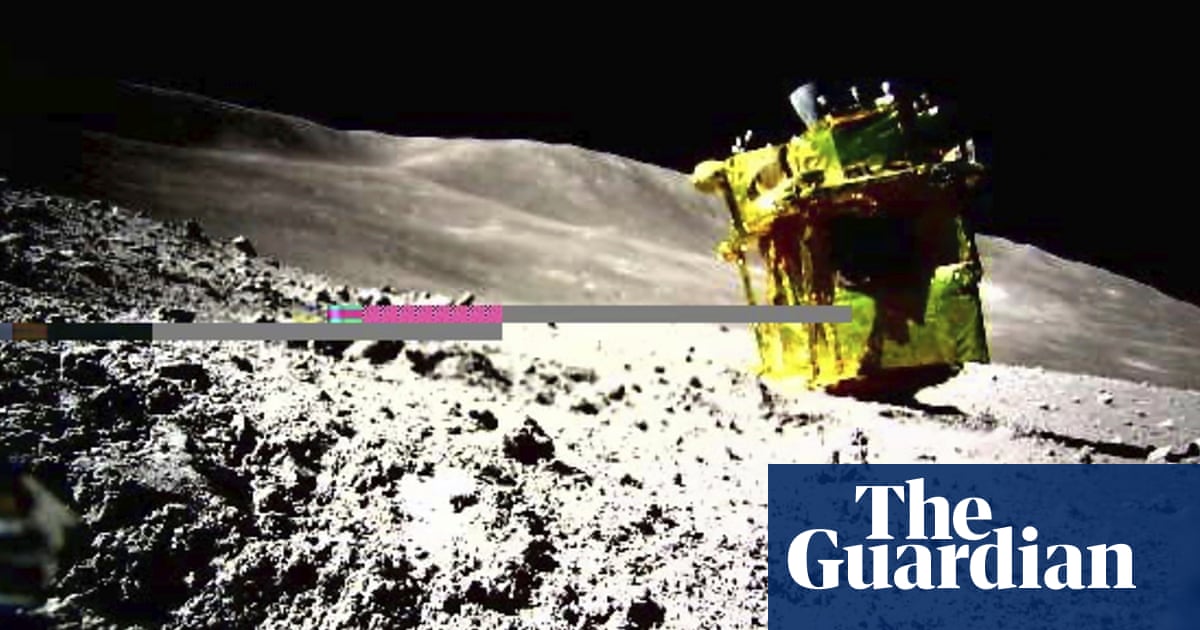They accidentally left it calibrated for an Australian launch.
I think it’s pretty impressive they managed to do a soft KSP-style landing without an engine nozzle.
Yeah, that’s the bigger deal. They lost an engine and still managed a soft landing. They just landed upside down – but the solar cells might still work.
And for the record, the lander was supposed to land on its side. It’s designed to do a quarter turn just before it touches the ground, but because of a slope, it rolled a little bit further than they wanted.
It was so close to perfect!
deleted by creator
deleted by creator
From a different article:
Angled westward because of the tumble, SLIM’s solar panels have been unable to generate electricity, but a change in the direction of sunlight could power it up before the next lunar sunset on Feb. 1 brings freezing cold
And another:
SLIM’s landing site is illuminated by sunlight until Feb. 1, and researchers are hoping that as the sun heads toward the west in lunar skies, the lander’s solar cells will soak up enough light to allow for the resumption of powered operations.
https://www.universetoday.com/165429/japan-slim-moon-lander-on-side/
It’s actually amazingly impressive! In contrast, in the past few years Israel, India and even Russia have had disappointing failures trying to land on the moon - not because they’re engineers aren’t as good, but because it’s just really freaking hard to get right and a lot of unexpected things can happen.
The Japanese team lost an engine nozzle and with it about 40% of their thrust as they were mid landing. Losing 1 out of 2 engines is the kind of critical malfunction that usually dooms a mission (like it did once for India); but regardless, their software was able to adjust on the fly, automatically switch into a different flight mode, and still put the lander exactly where they wanted it.
This is a remarkable success where so many talented others have failed. In a couple of weeks, the sun will be shining from the right direction to hit their solar panels and their mission should continue!
Having played rp-1 and had multiple landers slam into the moon at 2 km/s due to random engine failures, having the probe simply be upside down is quite fortunate.
Now I want to play RP-1 again. Never did manage to get to a manned mars mission that survived.
Wait, what game is RP-1?
Mod for KSP.
All the fun of building KSP rockets, and all of the pain of real rocket engines, part masses, ullage, life support for crew, and reliability issues.
You do get to see the real solar system in RP1 too, so it’s a lot of fun. Just can be kind of painful some times.
Oh, that sounds fantastic, I’ll have to look for it! Thanks!
If you’ve never modded KSP before, a word of warning: Use CKAN. It’s a mod manager for ksp.
You want RP1-express install.
RP1 is a big mod, it has a lot of dependencies, and installing everything manually will be very frustrating.
Thanks, that’s a great bit of advice.
I might have to try this out too.
I said the same thing when I crashed my mom’s car.
At least it wasn’t across 2 spaces
Liiike a glove!
Now they are just waiting for some wind.
Ok so just fire a laser at it to generate power in the solar panels?
Good idea! NASA do actually have a laser that can shine to the moon and back
Fun fact: the average laser’s collimation expands to the size of a football field by time it reaches the altitude of the ISS. The moon is 1,000x further. Despite the higher refinement of the laser used to bounce light off the retro reflector, it still takes an incredibly strong sensor to detect the bounce back. It’s not how The Big Bang Theory portrays it.
Now that this party is pooped, the sun is still stronger than anything we can beam. It might trickle charge. The rays that decrease exponentially with distance, coming from. 93 million miles away, still roasts us. Solar power is insane.
Edit: astronomers did actually beam a laser and get seen by the ISS. They used a very powerful, focused blue laser and tracking software to aim it on a powered mount. The tracking was necessary because they had to shine it when it was not illuminated. When we see the ISS lit in the night sky, they’re in full sun. The astronaut, Don Pettit who has an extensive photo portfolio, reported seeing a dim, flickering blue light coming from the ground and got a picture. He also saw the spotlights flashing. https://www.universetoday.com/93987/amateur-astronomers-flash-the-space-station/
deleted by creator
Wouldn’t shining back be counterproductive for this? You want the solar panels to harness the energy, not returning it to sender
Beaming the light back is a reference to completely separate items left on the moon: 6 reflectors (3 Apollo, 2 lunokhod, and 1 chandrayaan). It’s a grid of reflector cells like a huge, metal version of the reflectors you see on cars and bicycles. By measuring the time between shining the laser and recording it’s return, scientists can measure the exact distance to the moon and how it’s changing - both it’s orbital wobble and it’s drift.
So you’re correct, there’s no desire to have the laser bounce of the solar panels. The comment was just citing the existence of a light source powerful enough to reach the moon from earth.
I’m familiar with the Apollo retro-reflectors. Though in all seriousness I doubt a laser would provide a substantial amount of power (unless you have a specialty designed energy collector like in RFID)
Nevertheless, space officials are describing the mission as a success, despite the fact that the probe, nicknamed the “moon sniper”, appears to have tumbled down a crater slope, leaving its solar batteries facing in the wrong direction and unable to generate electricity.
So it’s like that time the SpaceX booster exploded near its landing craft due to missing it by meters?
Having played KSP, this situation actually seems pretty ok. It didn’t explode.
Oh shit appreciate the expert analysis
Lol I’ll be here all week!
I don’t know why people insist on trying to diss SpaceX anytime there’s space news… Anyway, last time they missed the Autonomous Drone Ship was years ago when they were first trying to land. So I’m not exactly sure what you are referring to.
Plus, with space missions there are usually many different mission objectives, and with this mission the main mission was to “demonstrate its highly precise navigation and landing system” which they determined to be a success. The extra credit mission would be if it landed properly and they were able to do more science with it.
I wasn’t insulting SpaceX, and don’t see why you think I am. I’m just making a comparison to better understand the situation. What you’ve described makes the two events all the more similar.
Fair enough. I’ve just been jaded from reading people bash on SpaceX anytime anything in space “fails”. But yeah, those events are similar in the sense that on the surface it looks like a failure, but they met their main mission goal and learned a lot from it. It sounds like the engine issue might’ve happened for them before, so hopefully they got a lot of good data from this and are able to fix the issue.
It’s important to keep in mind that going to space is very hard. Landing on another celestial body is order of magnitudes harder.
We could send Wallace and Gromit up there to flip it over…
You would think it would be designed to right itself from any orientation.
Why does a country with no ballistic missile program go for this sort of feat? Japan really has the tech base and uranium reprocessing ability to rocket into having ICBMs in no time.
Japan got struck twice with thermonuclear bombs in world war 2, in 2 cities named Hiroshima and Nagasaki. Look it up. They are very much against nuclear arms in general since then.
The populace is, for now. Expansions of the JDF and general worldwide rise in nationalism with Korea going nuclear, the decline of America and China being aggressive off of the Ryukyu islands can change that quite rapidly. I looked it up and there’s general consensus that they can build ICBMs in 6 months with their 9 ton stockpile of plutonium and enriched uranium and using their rockets off the shelf, if they haven’t already just secretly built the warheads and stored them.
Seems Abe had historically made noises in the general direction that having nuclear weapons wouldn’t be against the constitution as well. Very Japanese to have a face of nonproliferation and peacefulness while also positioning themselves with a full nuclear deterrent in their back pocket.
Edit: Also, those bad boys were simple fission bombs. Thermonuclear usually refers to fusion weapons. 6 month estimate would be a fission weapon boosted with tritium to increase the neutron flux and be a general very big bomb.
So you just live in your own little world, eh? Must be nice to have such a bubble.
Do you have an objection to a specific thing I said or are you just feeling sassy on the internet like usual?
Thanks, I was using thermonuclear wrong.
6 month estimate would be a fission weapon boosted with tritium to increase the neutron flux and be a general very big bomb.
Yeah but where are they gonna get a turbo-encabulator with a strong enough frammersham that can properly (and in a stable way no less) counter the non-ionic grametes?
They would need at least 30 kilometrics of unobtanium and completely bypass the impact of the global flange shaft shortage. Possible if they source solely from Malaysia, but 9 months minimum.
I think you may wanna lay off the Civ…













